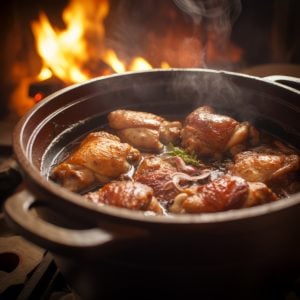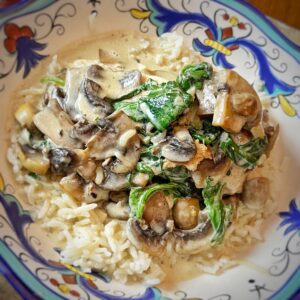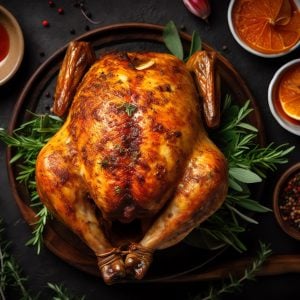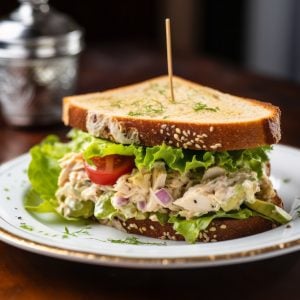Capon of your Dreams
Cooking a capon is a beautiful way to elevate a traditional poultry dish. It offers a richer, more succulent flavor than regular chicken. A capon is a rooster that has been castrated at a young age, which allows it to grow larger and develop tender, juicy meat. Its delicate flavor makes it ideal for special occasions or holiday meals.
Unlike chicken or turkey, they are typically more forgiving of overcooking, making them perfect for novice and experienced cooks alike. When preparing, the key is carefully treating it to enhance its natural flavors.
Roasting is the most common method, often accompanied by aromatic herbs, garlic, and citrus to complement the bird’s tenderness. A slow roast ensures the meat stays moist while achieving that golden, crispy skin everyone loves. They can also be stuffed with savory ingredients like bread, chestnuts, or dried fruits, adding an extra layer of flavor to your dish.
In this post, I’ll guide you through the steps to cook the perfect capon, ensuring it becomes the centerpiece of your next feast, whether for a holiday or a simple family dinner.
Are Capons Chicken?
Yes, capons are a type of chicken. Specifically, they are roosters (male chickens) castrated at a young age, typically before reaching sexual maturity. This process results in a bird that grows larger and develops more tender, flavorful meat than a regular rooster or hen. Capons are known for their rich taste, with more fat marbling, making their meat juicier and more delicate than standard chickens.
The castration process also affects their behavior, as capons are less aggressive than regular roosters and tend to have a more docile temperament. Their meat is often prized for special occasions or gourmet meals due to its succulent texture and milder flavor.
Cooking On a Charcoal Grill
Cooking a capon on a charcoal grill is a great way to add a smoky, savory flavor to this delicious bird. Here’s a basic guide:
Ingredients:
- 1 whole capon (4-6 lbs)
- Olive oil
- Salt and pepper
- Fresh herbs (thyme, rosemary, sage)
- Garlic cloves (optional)
- Lemon (optional)
Steps:
- Prepare the Capon: Pat it dry with paper towels and rub it with olive oil, salt, pepper, and your choice of herbs. Optionally, stuff the cavity with garlic cloves and lemon halves for extra flavor.
- Prepare the Grill: Place the charcoal on one side of your charcoal grill to set it up for indirect cooking. Preheat the grill to around 350°F (175°C).
- Grill the Capon: Place the capon on the cooler side of the grill, away from direct heat. Cover the grill and cook for 1.5 to 2 hours, maintaining a consistent temperature.
- Check the Temperature: The capon is done when it reaches an internal temperature of 165°F (74°C) in the thickest part of the thigh.
- Crisp the Skin: For a crispy finish, move the capon over direct heat for the last 5-10 minutes of cooking.
Let the capon rest for 10 minutes before carving. Enjoy!
Cooking On a Gas Grill
Cooking a capon on a gas grill is a convenient way to get that smoky, grilled flavor without the hassle of charcoal. Here’s how to do it:
Ingredients:
- 1 whole capon (4-6 lbs)
- Olive oil
- Salt and pepper
- Fresh herbs (thyme, rosemary, sage)
- Garlic cloves (optional)
- Lemon (optional)
Steps:
- Prepare the Capon: Start by patting it dry and rubbing it generously with olive oil, salt, pepper, and your choice of herbs. If you like, stuff the cavity with garlic cloves and lemon halves to enhance flavor.
- Prepare the Gas Grill: Preheat your gas grill to around 350°F (175°C). Set it up for indirect cooking by turning off the burners on one side while leaving the other side on.
- Grill the Capon: Place the capon on the side of the grill with no direct flame. This indirect cooking will allow the bird to roast slowly and evenly. Close the lid and grill for about 1.5 to 2 hours.
- Monitor the Temperature: Use a meat thermometer to check the capon’s internal temperature. It should reach 165°F (74°C) in the thickest part of the thigh.
- Crisp the Skin: For golden, crispy skin, move the capon over direct heat for the last 5-10 minutes of cooking.
Let the capon rest for 10-15 minutes before carving. This method yields a juicy, flavorful bird with a perfect smoky finish!
Cooking In the Oven
Cooking a capon in the oven is a classic and straightforward method that yields tender, flavorful meat with a crispy, golden skin. Here’s how to do it:
Ingredients:
- 1 whole capon (4-6 lbs)
- Olive oil or melted butter
- Salt and pepper
- Fresh herbs (thyme, rosemary, sage)
- Garlic cloves (optional)
- Lemon (optional)
- Vegetables (carrots, onions, potatoes for roasting, optional)
Steps:
- Prepare the Capon: Preheat your oven to 375°F (190°C). Pat it dry, then rub it generously with olive oil or melted butter. Season it well with salt, pepper, and herbs. To infuse flavor, stuff the cavity with garlic cloves, lemon halves, and more herbs.
- Prepare the Roasting Pan: Place it in a roasting pan. Surround it with vegetables like carrots, onions, and potatoes for a complete meal. These will roast in the capon’s drippings, absorbing extra flavor.
- Roast the Capon: Roast the capon uncovered for 1.5 to 2 hours. The cooking time depends on the bird’s size—allow about 20 minutes per pound. Baste the capon occasionally with its own juices to keep the meat moist.
- Check the Temperature: Use a meat thermometer to ensure the internal temperature of the thickest part of the thigh reaches 165°F (74°C).
- Rest and Serve: Let rest for 10-15 minutes before carving to allow the juices to redistribute.
This oven-roasting method produces a tender, juicy capon with crispy skin and rich, flavorful meat.













One Response
Sounds really good, what about the soaked hickory for smoke if you do it in a 325 oven?